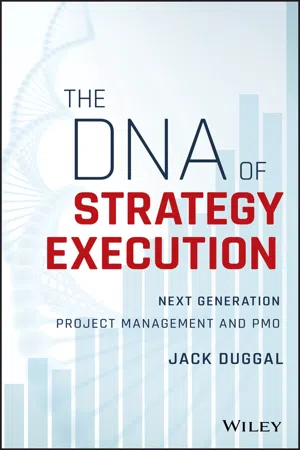
- English
- ePUB (mobile friendly)
- Available on iOS & Android
About this book
THE DNA OF STRATEGY EXECUTION
"In a world where there are more questions than answers every leader will need to learn to dance to a different beat. In this insightful book, Jack Duggal has cracked the DNA of Strategy Execution. Ignore these insights at your own peril."
—?Dr. Tony O'Driscoll
Global Head, DukeCE Labs, Duke Corporate Education
Fuqua School of Business, Duke University
DECODE THE DNA OF MANAGEMENT AND STRATEGY EXECUTION IN AN INCREASINGLY TURBULENT WORLD
Just as DNA contains the genetic instructions used in the development and functioning of all living organisms, what if we could decode the elements of management and strategy execution?
This insightful book offers new perspectives on age-old management challenges and illuminates better ways to organize and manage in an increasingly DANCE-world (Dynamic. Ambiguous. Non-Linear. Complex. Emergent). It puts the management DNA under the microscope, and shows how to develop, build and transform organizational project management and PMO capabilities essential for effective strategy execution. It provides a framework to measure what matters with a step-by-step approach to define and measure success and business value.
The DNA of Strategy Execution: Next Generation Project Management and PMO provides innovative insights for organizational project management and PMO. Based on application and learnings from many organizations around the world, this book reveals a playbook for strategy execution that will help you:
- Decode the core elements of management and strategy execution DNA
- Design and build next-generation Project/Program Management and PMO platform essential for effective strategy execution
- Prepare your organization to effectively lead and implement agile transformation and organizational change
- Improve organizational project management (OPM) and PMO maturity
- Improve overall organizational effectiveness and innovation capabilities
Whether you are a part of a startup, or an established incumbent organization, the impact of digitization and disruption requires a rethink and reset of how we organize and manage. This book presents a playbook for effective strategy execution with next-generation Project, Program and PMO capabilities.
Frequently asked questions
- Essential is ideal for learners and professionals who enjoy exploring a wide range of subjects. Access the Essential Library with 800,000+ trusted titles and best-sellers across business, personal growth, and the humanities. Includes unlimited reading time and Standard Read Aloud voice.
- Complete: Perfect for advanced learners and researchers needing full, unrestricted access. Unlock 1.4M+ books across hundreds of subjects, including academic and specialized titles. The Complete Plan also includes advanced features like Premium Read Aloud and Research Assistant.
Please note we cannot support devices running on iOS 13 and Android 7 or earlier. Learn more about using the app.
Information
1
INTRODUCTION: STRATEGY EXECUTION IN A DANCE‐WORLD
“The real voyage of discovery consists, not in seeking new landscapes, but in having new eyes.”Marcel Proust
RECOGNIZE THE DANCE: THE NEED TO RETHINK AND REDESIGN
“Any company designed for success in the 20th century is doomed to failure in the 21st.”David S. Rose, Angel Investing
Table of contents
- COVER
- TITLE PAGE
- TABLE OF CONTENTS
- 1 INTRODUCTION: STRATEGY EXECUTION IN A DANCE‐WORLD
- 2 AGILITY: RIGOR WITHOUT RIGIDITY
- 3 DNA OF STRATEGY EXECUTION
- 4 STRATEGY
- 5 EXECUTION
- 6 GOVERNANCE
- 7 CONNECT
- 8 MEASURE
- 9 CHANGE
- 10 LEARN
- 11 SIMPLIFY: BUILDING THE DEPARTMENT OF SIMPLICITY
- 12 BALANCE: DANCE‐ING ON THE EDGE OF CHAOS
- A APPLICATION OF DNA OF STRATEGY EXECUTION
- B PMO FUNCTIONS AND ACTIVITIES SERVICE CATALOG
- BIBLIOGRAPHY
- ACKNOWLEDGMENTS
- ABOUT THE AUTHOR
- INDEX
- END USER LICENSE AGREEMENT